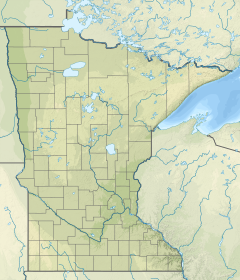geo.wikisort.org - River
The Knife River is a 23.9-mile-long (38.5 km)[2] river of northern Minnesota which drains a portion of Lake and Saint Louis counties into Lake Superior between Duluth and Two Harbors.[3]
| Knife River (Lake Superior) | |
|---|---|
 Knife River | |
 Mouth of the Knife River | |
| Location | |
| Country | United States |
| State | Minnesota |
| County | St. Louis, Lake County |
| Physical characteristics | |
| Source | |
| • location | King Lake |
| • coordinates | 47.1532623°N 91.7546197°W |
| Mouth | |
• location | Knife River, Minnesota, Lake Superior |
• coordinates | 46.9496578°N 91.7787897°W |
| Length | 23.9-mile-long (38.5 km) |
| Discharge | |
| • average | 90.3 cu ft/s (2.56 m3/s)[1] |
Name
The Knife River's name is an accurate preservation of its native Ojibwe name, Mokomani Zibi.[4][5] Its original name was probably given on account of the long, sharp stones near the mouth of the river.[6]
Geography
The main branch of the Knife River flows 23.9 miles (38.5 km) from source to mouth,[2] flowing parallel to the shoreline from the direction of Two Harbors.[1] It has four or five major tributaries.[1] Its watershed is 84.3 square miles (218 km2), and contains 181.1 miles (291.5 km) of streams.[7] Since data began being collected in 1974, its mean annual daily discharge of water has been calculated as 90.3 cubic feet per second (2.56 m3/s).[1] There is concern over the river's water quality due to suspended sediment, and it was placed on the state's impaired waters list in 1998.[8] A 2008 study found that about sixty percent of the sediment was coming from erosion of the streambanks, and about thirty from erosion of the river's bluffs.[1]
The Knife River's watershed is largely undeveloped, being 72% forest, 16% wetland, and 6% grassland.[7] 5% is used for agricultural purposes, and the remaining 1% is the unincorporated community of Knife River, Minnesota, located at the river's mouth.[7]
See also
References
- Nieber, John L., et al. Assessment of Streambank and Bluff Erosion in the Knife River Watershed. p. 6. Final Report Submitted to Minnesota Pollution Control Agency. Department of Bioproducts and Biosystems Engineering, University of Minnesota. 2008. Retrieved July 21, 2010.
- U.S. Geological Survey. National Hydrography Dataset high-resolution flowline data. The National Map Archived 2012-03-29 at the Wayback Machine, accessed May 7, 2012
- U.S. Geological Survey Geographic Names Information System: Knife River
- Gilfillan, J. A. Minnesota Geographical Names Derived from the Chippewa Language. p. 454. The Geological and Natural History Survey of Minnesota. Fifteenth Annual Report, 1886. Pioneer Press Company, St. Paul.
- Upham, Warren (1920). Minnesota Geographic Names: Their Origin and Historic Significance. Minnesota Historical Society. p. 492.
- The WPA Guide to the Minnesota Arrowhead Country, p. 162. Minnesota Historical Society Press, St. Paul, 1988.
- LakeSuperiorStreams: Community Partnerships For Understanding Water Quality and Stormwater Impacts at the Head of the Great Lakes. University of Minnesota-Duluth, Duluth, MN 55812. Knife River Watershed Retrieved July 21, 2010.
- Nieber, John L., et al. Assessment of Streambank and Bluff Erosion in the Knife River Watershed. p. 5. Final Report Submitted to Minnesota Pollution Control Agency. Department of Bioproducts and Biosystems Engineering, University of Minnesota. 2008. Retrieved July 21, 2010.
Другой контент может иметь иную лицензию. Перед использованием материалов сайта WikiSort.org внимательно изучите правила лицензирования конкретных элементов наполнения сайта.
WikiSort.org - проект по пересортировке и дополнению контента Википедии